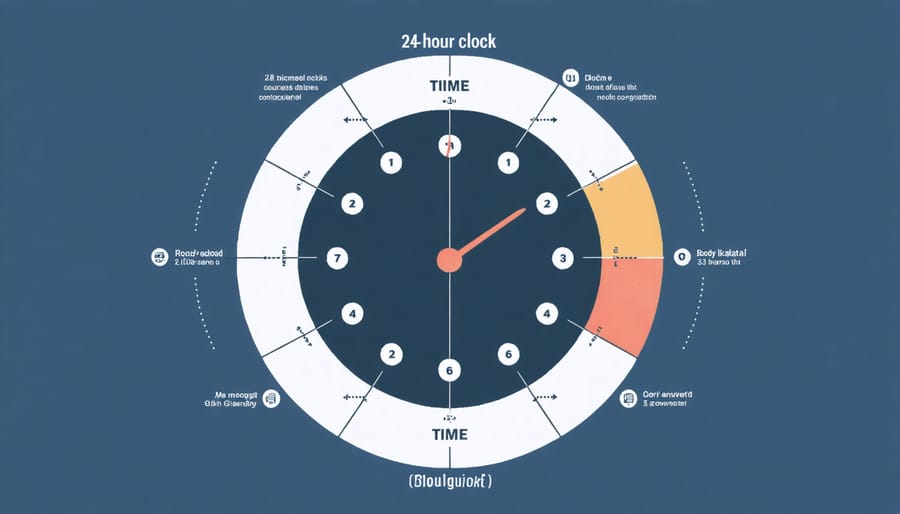Crossing multiple time zones disrupts our internal biological clock, triggering the exhausting battle between our body’s natural rhythms and a new local time – a phenomenon we know as jet lag. This misalignment affects not just our sleep patterns, but impacts everything from hormone production to body temperature regulation, making it one of the most challenging aspects of long-distance travel. While our circadian rhythm typically operates on a precise 24-hour cycle, synchronized with natural light and darkness, rapid travel across time zones forces this delicate system into chaos. Understanding this complex relationship between jet lag and our body’s master clock offers more than just scientific insight – it provides the foundation for effectively managing its symptoms. Recent research reveals that our ability to adapt to new time zones depends not just on travel direction and distance, but also on our pre-travel habits and in-flight strategies, opening new possibilities for minimizing jet lag’s impact on our daily function and overall well-being.
Understanding Your Internal Clock
The Science Behind Circadian Rhythm
Your body’s internal clock, known as the circadian rhythm, regulates numerous biological processes, including sleep, hormone production, and body temperature variations. This natural rhythm operates on a roughly 24-hour cycle and is primarily controlled by a region in your brain called the suprachiasmatic nucleus (SCN).
Light exposure plays a crucial role in regulating this internal clock. When light enters your eyes, it triggers signals that tell your brain whether it’s time to be alert or drowsy. This process involves the production of melatonin, often called the sleep hormone, which increases in the evening and decreases in the morning.
Your circadian rhythm influences more than just sleep patterns. It affects your appetite, mental alertness, immune system function, and even your mood. This complex system has evolved over millions of years to align with the Earth’s natural light-dark cycle, which is why disruptions to this rhythm can have such a significant impact on your well-being.
Understanding these biological processes is key to managing jet lag effectively and maintaining optimal health when traveling across time zones.

Key Body Functions Affected by Your Internal Clock
Your internal clock orchestrates numerous vital bodily functions throughout the day. One of its most noticeable influences is on your sleep-wake cycles, determining when you feel alert or drowsy. This natural rhythm also regulates hormone production, particularly melatonin (the sleep hormone) and cortisol (the stress hormone), which help maintain your daily energy patterns.
Beyond sleep and hormones, your circadian rhythm affects body temperature, digestion, and metabolism. Core body temperature naturally fluctuates throughout the day, typically reaching its lowest point in the early morning hours. Digestive processes are also timed to be most active during daylight hours, which is why eating late at night can sometimes cause discomfort.
Your immune system function, cognitive performance, and even mood are influenced by this internal clock. Many people experience peak alertness and concentration in the morning, while mental performance often dips in the early afternoon. Understanding these natural rhythms can help you optimize your daily activities and maintain better overall health.
How Jet Lag Disrupts Your Body Clock

Common Symptoms of Jet Lag
Jet lag can manifest through various physical and mental symptoms that affect your daily functioning. Common physical symptoms include extreme fatigue during the day, difficulty falling asleep at night, and digestive issues such as constipation or diarrhea. Many travelers also experience headaches and general body discomfort.
Mental symptoms are equally challenging and may include difficulty concentrating, mood changes, and feelings of mild disorientation. You might notice decreased alertness, impaired decision-making abilities, and irritability. Some people also report feeling slightly anxious or experiencing mild depression-like symptoms.
The severity and duration of these symptoms typically depend on the number of time zones crossed and the direction of travel. Eastward travel often causes more severe jet lag symptoms than westward travel because it’s harder for our bodies to adapt to a shortened day than a lengthened one.
Most people find that these symptoms are strongest during the first few days after arrival and gradually improve as their body adjusts to the new time zone. However, it’s important to note that everyone experiences jet lag differently, and some individuals may be more sensitive to time zone changes than others.
Why Different Directions Affect You Differently
When it comes to jet lag, the direction you travel makes a significant difference in how your body adapts. Flying east generally causes more severe jet lag than traveling west, and there’s a scientific reason for this. Our internal body clock naturally runs on a cycle slightly longer than 24 hours, making it easier to extend our day (traveling west) than to shorten it (traveling east).
When you fly east, you’re essentially forcing your body to fall asleep earlier than usual. For example, if you travel from Vancouver to Toronto, you need to adjust to a three-hour time difference by going to bed earlier, which can be particularly challenging for your circadian rhythm. Conversely, when flying west from Toronto to Vancouver, your body only needs to stay awake longer, which aligns more naturally with our internal clock’s tendency to drift.
This difference explains why many travelers find it takes roughly one day per time zone to adjust when traveling east, while western travel typically requires only half that time. Understanding this biological preference can help you better plan your travel schedule and adjustment strategies.

Practical Strategies to Reset Your Body Clock
Before Your Trip
Preparing for jet lag before your journey can significantly reduce its impact on your well-being. Just as we develop strategies for adjusting to time changes during daylight saving transitions, pre-travel preparation is essential for maintaining your body’s natural rhythm.
Start adjusting your sleep schedule gradually about a week before departure. If you’re traveling east, try going to bed and waking up one hour earlier each day. For westward travel, delay your bedtime and wake time by one hour daily. This gentle shift helps your body begin adapting to your destination’s time zone.
Maintain a consistent sleep routine in the days leading up to your trip. Aim for 7-9 hours of quality sleep each night, and avoid sleep debt, which can worsen jet lag symptoms. Regular exercise during daylight hours can help strengthen your circadian rhythm, but avoid intense workouts close to bedtime.
Consider your meal timing as well. Begin shifting your mealtimes to match your destination’s schedule. Stay well-hydrated and limit caffeine and alcohol consumption in the days before travel. If possible, schedule your arrival during daylight hours at your destination, as natural light exposure can help reset your internal clock more effectively.
Pack items that can support healthy sleep, such as an eye mask, earplugs, and any sleep aids recommended by your healthcare provider. Having these tools ready will help you maintain good sleep habits during your journey.
During Your Flight
During your flight, making strategic choices can help minimize disruption to your circadian rhythm. Start by adjusting your watch to your destination’s time zone as soon as you board, helping your mind begin the transition. If it’s nighttime at your destination, try to sleep on the plane using an eye mask and earplugs to create a dark, quiet environment.
Stay well-hydrated throughout the flight, but avoid caffeine and alcohol as these can interfere with your sleep patterns and contribute to dehydration. When it’s daytime at your destination, try to stay awake by engaging in light activities like reading or watching movies. Take advantage of the plane’s lighting system, which is often designed to help with time zone transitions.
Moving around the cabin every few hours helps maintain circulation and can help you stay alert when needed. Simple exercises like ankle rotations, shoulder rolls, and gentle stretches can be done right in your seat. If you need to sleep, aim for shorter naps (20-30 minutes) rather than long periods of sleep, unless it’s nighttime at your destination.
Consider bringing healthy snacks and eating light meals that align with your destination’s meal times. This helps your body’s internal clock begin adjusting to the new schedule even before you land. Remember that exposure to natural light plays a crucial role in regulating your circadian rhythm, so open your window shade when it’s daytime at your destination.
After Arrival
Once you’ve reached your destination, taking specific steps can help your body adjust more quickly to the new time zone. Start by exposing yourself to natural daylight during the local daytime hours, as sunlight is one of the strongest signals for resetting your internal clock. If you arrive during the day, try to stay awake until the local nighttime, even if you feel tired.
Maintain regular meal times according to your new time zone, as eating patterns play a significant role in circadian rhythm adjustment. Stay hydrated and avoid excessive caffeine, which can interfere with your sleep patterns. Light exercise, such as walking or gentle stretching, can help combat fatigue and promote better sleep, but avoid vigorous workouts close to bedtime.
Create an environment conducive to sleep in your accommodation by keeping the room dark, quiet, and cool. If you need to rest during the day, limit naps to 20-30 minutes to prevent disrupting your nighttime sleep. Some travelers find it helpful to use sleep aids temporarily, but it’s best to consult with a healthcare provider before using any sleep medications.
Remember that it typically takes about one day per time zone crossed for your body to fully adjust. Be patient with yourself and maintain consistent sleep and wake times to help establish your new rhythm more effectively.
Understanding and managing jet lag doesn’t have to be overwhelming. By recognizing how our circadian rhythm responds to travel across time zones, we can take proactive steps to minimize its impact on our well-being. Remember that prevention is often more effective than trying to deal with jet lag after it occurs. By gradually adjusting your sleep schedule before travel, staying hydrated, and managing light exposure strategically, you can help your body adapt more smoothly to new time zones.
Whether you’re a frequent traveler or planning a special trip, implementing these evidence-based strategies can help you maintain your energy levels and enjoy your destination sooner. Keep in mind that everyone’s body responds differently to time zone changes, so it may take some experimentation to find what works best for you. With proper planning and patience, you can effectively manage jet lag symptoms and maintain a healthy sleep-wake cycle, even when traveling across multiple time zones.
Most importantly, be gentle with yourself during the adjustment period and allow your body the time it needs to synchronize with your new environment.

